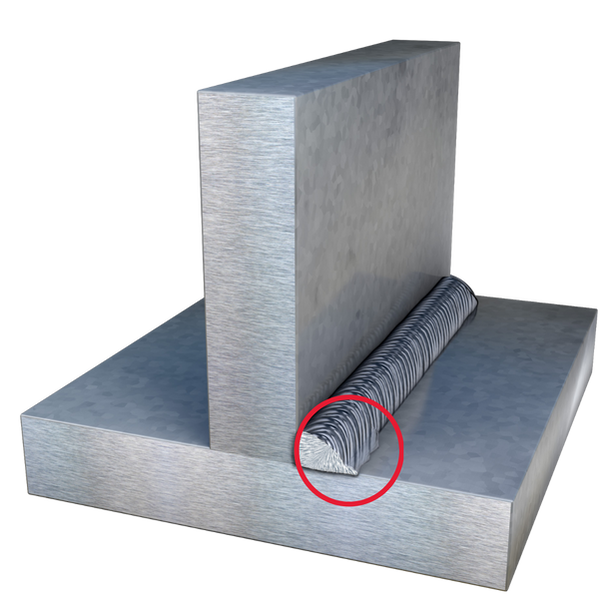Recognizing the Causes and Solutions for Undercut Welding in Steel Manufacture Procedures
In the world of steel manufacture procedures, the event of undercut welding postures a substantial obstacle that requires a thorough understanding of its reasons and sensible remedies. The detailed interaction of numerous aspects throughout welding operations can result in this undesirable phenomenon, impacting the architectural honesty and general high quality of the welded joints - Preventing weld undercut. By dissecting the root creates of undercut welding and discovering efficient remedial measures, makers can boost the requirement of their craftsmanship and ensure the production of remarkable metal components
Usual Reasons For Undercut Welding
Frequently ignored in steel manufacture, undercut welding takes place due to various elements that demand careful focus and expertise to be effectively reduced. Furthermore, incorrect welding methods, such as utilizing the incorrect welding angle or take a trip rate, can likewise add to damage development. The option of welding specifications, such as voltage, current, and wire feed speed, plays a significant role in the occurrence of undercut welding.
Impact of Incorrect Welding Parameters
Incorrect welding parameters can considerably compromise the integrity and quality of welded joints in steel manufacture procedures. The effect of inaccurate welding parameters manifests in various means, bring about architectural weaknesses and problems in the welded parts. One essential facet impacted by improper welding parameters is the infiltration deepness of the weld. Inadequate heat input as a result of reduced welding currents or excessively high traveling rates can lead to inadequate blend between the base metals, bring about insufficient joint penetration and weakened bonds. Alternatively, extreme heat input created by high welding currents or sluggish travel rates can result in too much and burn-through reinforcement, creating a weak and unsteady weld framework. Furthermore, incorrect criteria such as improper voltage setups or incorrect electrode angles can add to unpredictable weld grain profiles, absence of combination, and increased possibilities of defects like damaging. Precise focus to welding parameters is vital to ensure the production of high-grade welds with the desired mechanical residential properties and structural integrity.
Impact of Improper Lantern Angle
Incorrect torch angle in welding operations can significantly influence the top quality and stability of the final weld joints in metal manufacture procedures. Undercutting is a common welding issue where a groove creates along the weld toe, deteriorating the joint and jeopardizing its structural honesty.
A torch angle that is too high can cause inadequate penetration, incomplete blend, and boosted spatter. On the other hand, a torch angle that is also shallow can result in too much infiltration, burn-through, and distortion of the base material. Preventing weld undercut. Correct lantern angle is vital for guaranteeing consistent weld top quality, stamina, and appearance
To avoid damaging and other issues brought on by improper lantern angles, welders should be educated to preserve the correct lantern angle throughout the welding process. Normal tracking and change of torch angles throughout welding can assist achieve audio welds with minimal flaws.
Role of Inadequate Welding Strategies

One more element of insufficient welding methods is inappropriate weld preparation. Inadequate cleansing of the base steels, inaccurate joint style, or insufficient side preparation can all add to undercut welding. Inadequate securing gas insurance coverage or using the wrong type of gas can result in insufficient blend and the development of undercut problems.
To deal with the role of poor welding methods in metal fabrication procedures, it is vital to supply extensive training for welders. Proper education and find out here learning on welding specifications, joint preparation, and protecting gas choice can aid stop undercut welding and guarantee top quality welds in steel construction projects.
Efficient Solutions for Undercut Welding
Dealing with undercut welding in steel construction requires carrying out effective remedies to enhance weld high quality and structural stability. One of the main solutions to deal with undercut is to adjust welding criteria such as voltage, current, and take a trip speed to make sure proper warm input and blend. By fine-tuning these settings, welders can protect against excessive melting of the base steel and filler product, decreasing the chance of undercut formation.
In addition, proper joint preparation is critical in avoiding undercut. Making certain clean base metal surface areas free of pollutants and making use of the appropriate bevel angle can assist advertise far better weld penetration and minimize the threat of undercut - Preventing weld undercut. Employing suitable welding methods, such as oscillating the torch or weaving, can likewise help in dispersing warmth evenly and filling the weld joint effectively, minimizing the possibility of undercut problems
Moreover, picking the proper welding consumables, including electrodes and filler metals, is important in alleviating undercut. Making use of products with ideal chemical make-ups and mechanical homes can add to accomplishing sound welds with very little undercut. Routine assessment and quality assurance actions need to additionally be applied to detect and address undercut issues promptly, ensuring the total honesty of made steel elements.

Final Thought
In final thought, comprehending the causes and solutions for undercut welding in metal manufacture procedures is vital for accomplishing premium welds. By dealing with common causes such as wrong welding specifications, incorrect torch angle, and poor welding strategies, welders can stop undercutting and ensure solid, long lasting welds. It is necessary to focus on these factors and apply efficient solutions to boost the general welding process and end product top quality.
